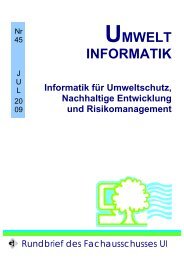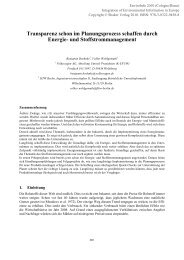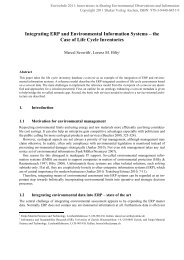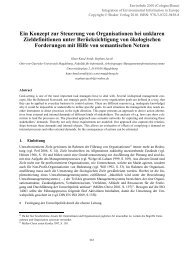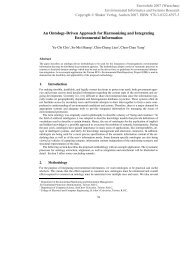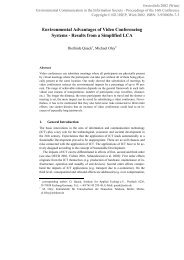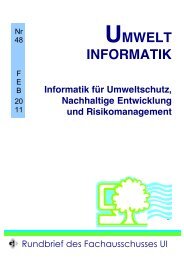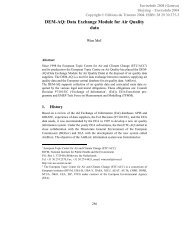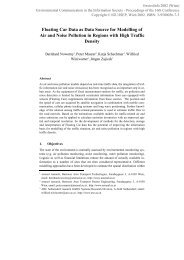Environmental ICT applications for eco-industrial ... - EnviroInfo
Environmental ICT applications for eco-industrial ... - EnviroInfo
Environmental ICT applications for eco-industrial ... - EnviroInfo
Create successful ePaper yourself
Turn your PDF publications into a flip-book with our unique Google optimized e-Paper software.
The impacts of <strong>ICT</strong> on individuals, society, and nature are classified according to three different<br />
perspectives:<br />
• Effects of <strong>ICT</strong> provision, e.g. use of resources and energy in manufacturing, use and disposal<br />
of <strong>ICT</strong> hardware.<br />
• Effects of <strong>ICT</strong> use, e.g. energy savings from process optimisation or commuter traffic reduction<br />
as a result of tel<strong>eco</strong>mmunication.<br />
• Systemic effects, e.g. rebound effects as a reaction to efficiency gains, changes of <strong>eco</strong>nomic<br />
structures, institutions and consequences <strong>for</strong> individual lifestyles.<br />
The combination of sustainability criteria and levels of <strong>ICT</strong> impacts results in a 3x3 matrix. For all<br />
nine fields, status quo and practical r<strong>eco</strong>mmendations towards a more sustainable in<strong>for</strong>mation society<br />
are described. For example, r<strong>eco</strong>mmendations <strong>for</strong> <strong>ICT</strong> provision cover measures to create and maintain<br />
an <strong>ICT</strong> infrastructure in a more sustainable manner. Apart from direct effects of provision and use,<br />
<strong>ICT</strong> lead to a number of rebound effects which must be neutralised so that achieved efficiency gains<br />
and possible resource savings are not offset by other, wasteful ways of using <strong>ICT</strong> (<strong>eco</strong>logical compatibility).<br />
The impact-driven approach is a reminder that the development of environmental <strong>ICT</strong> <strong>applications</strong><br />
<strong>for</strong> <strong>industrial</strong> symbiosis projects is not merely a technical issue <strong>for</strong> computer scientists within <strong>Environmental</strong><br />
In<strong>for</strong>matics. It is also an issue <strong>for</strong> users involved in <strong>eco</strong>-<strong>industrial</strong> developments, and hence<br />
it is a matter of Industrial Ecology, particularly in terms of environmental impact assessment.<br />
3. Inventory of <strong>industrial</strong> symbiosis projects in Europe<br />
The basic idea underlying <strong>industrial</strong> symbiosis projects is that <strong>eco</strong>nomic entities share in<strong>for</strong>mation,<br />
services, utilities, and by-product resources among one or more <strong>industrial</strong> actors with the aim to add<br />
value, reduce costs, and improve environmental per<strong>for</strong>mance (Côté and Cohen-Rosenthal 1998; Chertow<br />
2007). Typically, these projects have a particular focus on material and energy exchange, while<br />
<strong>eco</strong>nomic entities are often from separate industries. They are brought together in a collective approach.<br />
The characteristics are collaboration and synergistic possibilities offered by geographic proximity.<br />
Economic entities involved in <strong>industrial</strong> symbiosis projects may collectively optimize material<br />
and energy use across single entities. Consequently, considering efficiencies goes beyond those<br />
achievable by any individual process alone. It is ideally more like behaviour of a local community.<br />
Due to the promising approach, <strong>industrial</strong> symbiosis projects have been initiated worldwide (critical:<br />
Gibbs and Deutz 2005, 2007). Various examples could be found in Europe (e.g. Eilering and<br />
Vermeulen 2004; Liwarska-Bizukojc et al. 2009), USA & Canada (e.g. Chertow 2007; Gibbs and<br />
Deutz 2007), Asia (e.g. Chiu and Yong 2004; Park et al. 2008), and Australia (e.g. Roberts 2004; van<br />
Berkel 2006;). Though is seems useful to having a full r<strong>eco</strong>rd of <strong>industrial</strong> symbiosis projects available,<br />
a central inventory is missing, yet. No comprehensive catalogue exists that is online or publicly<br />
available, not even offered by the ISIE.<br />
An inventory − preferably accessible online − would be a valuable source to better analyze <strong>industrial</strong><br />
symbiosis projects, e.g. to identify success factors and detect obstacles. Particularly an inventory<br />
would also be fruitful to investigate the role of <strong>ICT</strong> in <strong>industrial</strong> symbiosis projects. The following table<br />
may be a starting point <strong>for</strong> such enterprise. The collection includes a total of more than 70 examples,<br />
located in 12 European countries. The collection is just a snapshot. It is not based on a systematic<br />
research method. The examples identified have been extracted from the current Industrial Ecology literature<br />
and a survey in the internet.<br />
230<br />
Copyright © Shaker Verlag 2009. ISBN: 978-3-8322-8397-1






